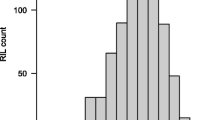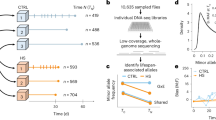Abstract
The genomic basis of ageing still remains unknown despite being a topic of study for many years. Here, we present data from 20 experimentally evolved laboratory populations of Drosophila melanogaster that have undergone two different life-history selection regimes. One set of ten populations demonstrates early ageing whereas the other set of ten populations shows postponed ageing. Additionally, both types of populations consist of five long standing populations and five recently derived populations. Our primary goal was to determine which genes exhibit changes in expression levels by comparing the female transcriptome of the two population sets at two different time points. Using three different sets of increasingly restrictive criteria, we found that 2.1–15.7% (82–629 genes) of the expressed genes are associated with differential ageing between population sets. Conversely, a comparison of recently derived populations to long-standing populations reveals little to no transcriptome differentiation, suggesting that the recent selection regime has had a larger impact on the transcriptome than its more distant evolutionary history. In addition, we found very little evidence for significant enrichment for functional attributes regardless of the set of criteria used. Relative to previous ageing studies, we find little overlap with other lists of aging related genes. The disparity between our results and previously published results is likely due to the high replication used in this study coupled with our use of highly differentiated populations. Our results reinforce the notion that the use of genomic, transcriptomic, and phenotypic data to uncover the genetic basis of a complex trait like ageing can benefit from experimental designs that use highly replicated, experimentally-evolved populations.





Similar content being viewed by others
References
Anders S, McCarthy DJ, Chen Y, Okoniewski M, Smyth GK, Huber W, Robinson MD (2013) Count-based differential expression analysis of RNA sequencing data using R and Bioconductor. Nat Protoc 8(9):1765–1786
Andrews S (2010) FastQC: a quality control tool for high throughput sequence data. Babraham Institute. Available at http://www.bioinformatics.babraham.ac.uk/projects/fastqc/
Ayyadevara S, Alla R, Thaden JJ, Shmookler Reis RJ (2008) Remarkable longevity and stress resistance of nematode PI3 K-null mutants. Aging Cell 7(1):13–22
Baruzzo G, Hayer KE, Kim EJ, Di Camillo B, FitzGerald GA, Grant GR (2017) Simulation-based comprehensive benchmarking of RNA-seq aligners. Nat Methods 14(2):135–139
Benjamini Y, Hochberg Y (1995) Controlling the false discovery rate—a practical and powerful approach to multiple testing. J R Stat Soc Ser B 57(1):289–300
Bolger AM, Lohse M, Usadel B (2014) Trimmomatic: a flexible trimmer for Illumina sequence data. Bioinformatics 30(15):2114–2120
Braendle C, Heyland A, Flatt T (2011) Integrating mechanistic and evolutionary analysis of life history variation. In: Flatt T, Heyland A (eds) Mechanisms of life history evolution: the genetics and physiology of life history traits and trade-offs. Oxford University Press, New York, pp 1–10
Bray NL, Pimentel H, Melsted P, Pachter L (2016) Erratum: near-optimal probabilistic RNA-seq quantification. Nat Biotechnol 34(8):888
Bryant DM, Johnson K, DiTommaso T, Tickle T, Couger MB, Payzin-Dogru D, Lee TJ, Leigh ND, Kuo T-H, Davis FG et al (2017) A tissue-mapped axolotl de novo transcriptome enables identification of limb regeneration factors. Cell Rep 18(3):762–776
Burke MK, Barter TT, Cabral LG, Kezos JN, Phillips MA, Rutledge GA, Phung KH, Chen RH, Nguyen HD, Mueller LD et al (2016) Rapid divergence and convergence of life-history in experimentally evolved Drosophila melanogaster. Evolution 70(9):2085–2098
Cardoso-Moreira M, Arguello JR, Gottipati S, Harshman LG, Grenier JK, Clark AG (2016) Evidence for the fixation of gene duplications by positive selection in Drosophila. Genome Res 26(6):787–798
Carlson KA, Gardner K, Pashaj A, Carlson DJ, Yu F, Eudy JD, Zhang C, Harshman LG (2015) Genome-wide gene expression in relation to age in large laboratory cohorts of Drosophila melanogaster. Genet Res Int 2015:835624
Cridland JM, Thornton KR, Long AD (2015) Gene expression variation in Drosophila melanogaster due to rare transposable element insertion alleles of large effect. Genetics 199(1):85–93
da Huang W, Sherman BT, Lempicki RA (2009) Systematic and integrative analysis of large gene lists using DAVID bioinformatics resources. Nat Protoc 4(1):44–57
Dayan DI, Crawford DL, Oleksiak MF (2015) Phenotypic plasticity in gene expression contributes to divergence of locally adapted populations of Fundulus heteroclitus. Mol Ecol 24(13):3345–3359
de Magalhaes JP (2014) Why genes extending lifespan in model organisms have not been consistently associated with human longevity and what it means to translation research. Cell Cycle 13(17):2671–2673
Development Core Team R (2016) R: a language and environment for statistical computing. R Foundation for Statistical Computing, Vienna
Deveson IW, Hardwick SA, Mercer TR, Mattick JS (2017) The dimensions, dynamics, and relevance of the mammalian noncoding transcriptome. Trends Genet 33(7):464–478
Dobin A, Davis CA, Schlesinger F, Drenkow J, Zaleski C, Jha S, Batut P, Chaisson M, Gingeras TR (2013) STAR: ultrafast universal RNA-seq aligner. Bioinformatics 29(1):15–21
dos Santos G, Schroeder AJ, Goodman JL, Strelets VB, Crosby MA, Thurmond J, Emmert DB, Gelbart WM, FlyBase C (2015) FlyBase: introduction of the Drosophila melanogaster release 6 reference genome assembly and large-scale migration of genome annotations. Nucleic Acids Res 43(Database issue):D690–D697
Garland T, Rose MR (2009) Experimental evolution. University of California Press, Berkeley, CA
Graveley BR, Brooks AN, Carlson JW, Duff MO, Landolin JM, Yang L, Artieri CG, van Baren MJ, Boley N, Booth BW et al (2011) The developmental transcriptome of Drosophila melanogaster. Nature 471(7339):473–479
Graves JL Jr, Hertweck KL, Phillips MA, Han MV, Cabral LG, Barter TT, Greer LF, Burke MK, Mueller LD, Rose MR (2017) Genomics of parallel experimental evolution in Drosophila. Mol Biol Evol 34(4):831–842
Hastie T, Tibshirani R, Friedman JH (2009) The elements of statistical learning: data mining, inference, and prediction. Springer, New York
Hsu SK, Jaksic AM, Nolte V, Barghi N, Mallard F, Otte KA, Schlotterer C (2019) A 24 h age difference causes twice as much gene expression divergence as 100 generations of adaptation to a novel environment. Genes 10(2):89
Hubley R, Finn RD, Clements J, Eddy SR, Jones TA, Bao W, Smit AF, Wheeler TJ (2016) The Dfam database of repetitive DNA families. Nucleic Acids Res 44(D1):D81–D89
Kolde R (2015) pheatmap: Pretty Heatmaps. R package version 1.0.8
Li H, Handsaker B, Wysoker A, Fennell T, Ruan J, Homer N, Marth G, Abecasis G, Durbin R, Genome Project Data Processing S (2009) The sequence alignment/map format and SAMtools. Bioinformatics 25(16):2078–2079
Love MI, Huber W, Anders S (2014) Moderated estimation of fold change and dispersion for RNA-seq data with DESeq2. Genome Biol 15(12):550
Mallard F, Nolte V, Tobler R, Kapun M, Schlotterer C (2018) A simple genetic basis of adaptation to a novel thermal environment results in complex metabolic rewiring in Drosophila. Genome Biol 19(1):119
Matthews BB, dos Santos G, Crosby MA, Emmert DB, St Pierre SE, Gramates LS, Zhou PL, Schroeder AJ, Falls K, Strelets V et al (2015) Gene model annotations for Drosophila melanogaster: impact of high-throughput data. G3 5(8):1721–1736
Mueller LD, Phillips MA, Barter TT, Greenspan ZS, Rose MR (2018) Genome-wide mapping of gene-phenotype relationships in experimentally evolved populations. Mol Biol Evol 35(8):2085–2095
Petersen A, Witten D, Simon N (2016) Fused lasso additive model. J Comput Graph Stat 25(4):1005–1025
Remolina SC, Chang PL, Leips J, Nuzhdin SV, Hughes KA (2012) Genomic basis of aging and life-history evolution in Drosophila melanogaster. Evolution 66(11):3390–3403
Rose MR (1984) Laboratory evolution of postponed senescence in Drosophila melanogaster. Evolution 38(5):1004–1010
Rose MR, Burke MK (2011) Genomic croesus: experimental evolutionary genetics of Drosophila aging. Exp Geront 46(5):397–403
Rose MR, Passananti HB, Matos M (2004) Methuselah flies. World Scientific Publishing, Singapore
Sarup P, Sørensen JG, Kristensen TN, Hoffmann AA, Loeschcke V, Paige KN, Sørensen P (2011a) Candidate genes detected in transcriptome studies are strongly dependent on genetic background. PLoS ONE 6(1):e15644
Sarup P, Sørensen P, Loeshcke V (2011b) Flies selected for longevity retain a young gene expression profile. Age 33(1):69–80
Saurin W, Hofnung M, Dassa E (1999) Getting in or out: early segregation between importers and exporters in the evolution of ATP-binding cassette (ABC) transporters. J Mol Evol 48(1):22–41
Scheiner SM, Barfield M, Holt RD (2012) The genetics of phenotypic plasticity. XI. Joint evolution of plasticity and dispersal rate. Ecol Evol 2(8):2027–2039
Wickham H (2016) ggplot2: elegant graphics for data analysis. Springer, New York
Yang L, Duff MO, Graveley BR, Carmichael GG, Chen LL (2011) Genomewide characterization of non-polyadenylated RNAs. Genome Biol 12(2):R16
Acknowledgements
We thank Bryan Clifton for technical help and to the University of California, Irvine High-Performance Computing cluster for facilitating our analyses. This work was supported by a FRT UCI award to J.M.R. and, in part, through access to the Genomics High Throughput Facility Shared Resource of the Cancer Center Support Grant (P30CA-062203) at the University of California, Irvine and NIH shared instrumentation grants 1S10RR025496-01, 1S10OD010794-01, and 1S10OD021718-01 and from funds provided by the UCI School of Biological Sciences.
Author information
Authors and Affiliations
Corresponding author
Additional information
Publisher's Note
Springer Nature remains neutral with regard to jurisdictional claims in published maps and institutional affiliations.
Electronic supplementary material
Below is the link to the electronic supplementary material.
10522_2019_9823_MOESM1_ESM.tiff
Supplementary material 1—Timeline of the generation of the experimentally evolved populations of D. melanogaster used. Any terminal arrow denotes five populations. In parenthesis, number of generations elapsed of separated evolution for a particular subset of populations. All evolved populations analyzed derive ultimately from an outbred population, named IV, collected at South Amherst, MA (Rose 1984). More recently, all evolved populations are derived from an ancestral treatment “O”, which is characterized by a generation length of 70 days. Initially, the “CO” populations were derived from the “O” populations by following the C-type selection regime, which entailed a 28-day generation length. From the “CO” lines, the “ACO” populations were generated by applying the A-type selection regime of accelerated development, shortening the generation length to 10 days. Lastly, the “NCO” and “AO” treatments derived from the original “O” populations undergoing again the mentioned C-type and A-type selection regimes, respectively. (TIFF 177 kb)
10522_2019_9823_MOESM2_ESM.eps
Supplementary material 2—Principle component analysis (PCA) plots. PCA was done for 14- and 21-day time points (left and right, respectively) using normalized RNA-seq count data for ten early reproducing populations (five ACO and five AO) and ten late reproducing populations (five CO and five nCO). The proportion of variance explained by each component is indicated. For both time points, the grouping of the populations recapitulates the type of selection regime to which they were exposed. (EPS 18 kb)
10522_2019_9823_MOESM3_ESM.eps
Supplementary material 3—Correlation matrices among expression levels across populations. Correlation matrices were generated for 14- and 21-day time points (left and right, respectively) using normalized RNA-seq count data from each population. For both time points, the clustering of the populations precisely segregates to which of the two selection regimes the populations were individually exposed. Equivalent randomized expression data (per gene across populations) yielded no equivalent perfect segregation of populations based on their association with a particular treatment (P<0.001; 1000 randomized datasets). The average correlations values were 0.986 and 0.987 at day 14, and 0.986 and 0.987 at day 21, for the A- and C-population types, respectively. The identity of each population is shown on the right and at the bottom of each chart. (EPS 3037 kb)
Rights and permissions
About this article
Cite this article
Barter, T.T., Greenspan, Z.S., Phillips, M.A. et al. Drosophila transcriptomics with and without ageing. Biogerontology 20, 699–710 (2019). https://doi.org/10.1007/s10522-019-09823-4
Received:
Accepted:
Published:
Issue Date:
DOI: https://doi.org/10.1007/s10522-019-09823-4




